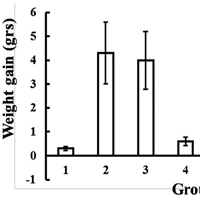 Smart Citations
Smart CitationsSee how this article has been cited at scite.ai
scite shows how a scientific paper has been cited by providing the context of the citation, a classification describing whether it supports, mentions, or contrasts the cited claim, and a label indicating in which section the citation was made.
The effect of artificial sweeteners on body weight of mice
Artificial Sweeteners (AS) are synthetic sugar substitutes that have sweetening potency hundreds of times more than the table sugar (sucrose). Artificial sweeteners are regarded as attractive alternatives to sugar as they add no calories to food intake. There are many hypotheses suggesting that AS may enhance appetite and cause weight gain. The aim of this study was to evaluate the effect of AS on food intake, fluid intake and body weight of mice. Acceptable daily intakes of AS solutions were administered orally to different set of mice for four weeks. The body weight, food consumption and fluid intake were measured. At the same time, the effect of Zingiber officinale extracts (natural appetite suppressor), Thymus vulgaris extracts (natural appetite inducer) and cyproheptadine (an appetite stimulant drug) on body weight of mice was evaluated. Artificial sweeteners consumption cause insignificant changes in body weight (p>0.05). However, the mean consumption of food and solutions varies significantly for some groups. The consumption of AS has no significant effect on body weight and may contribute to weight maintenance and energy balance as substitutes to high caloric sugar
How to Cite
PAGEPress has chosen to apply the Creative Commons Attribution NonCommercial 4.0 International License (CC BY-NC 4.0) to all manuscripts to be published.

 https://doi.org/10.4081/jbr.2020.8783
https://doi.org/10.4081/jbr.2020.8783




